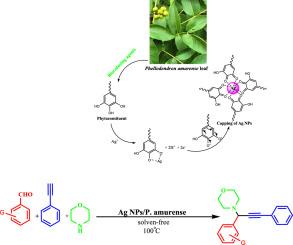黄柏叶提取物绿色纳米银对NCI-H661人肺腺癌细胞的抗凋亡作用及PI3K/AKT/mTOR信号通路及其在A3偶联反应中的应用
IF 2.1
3区 化学
Q3 CHEMISTRY, INORGANIC & NUCLEAR
引用次数: 0
摘要
由于植物提取物是化学过程的简单、无害环境和生理安全的替代品,人们对利用它们制造纳米银(Ag NPs)越来越感兴趣。本研究描述了一种以黄柏叶片水提物为还原剂,以AgNO3为原料,经济高效、环保地绿色合成银纳米粒子的方法。苦参叶提取物中酚类羟基官能团具有封盖/稳定和还原作用。Ag NPs/P。采用UV-Vis、TEM、SEM、EDX、ICP-OES、XRD等技术对纳米复合材料进行了表征。SEM和TEM结果表明,制备的银纳米颗粒呈球形结构,粒径在20 ~ 30 nm之间。采用NCI-H661人肺腺癌细胞株,评价其生物源性Ag NPs/P。苦参纳米复合材料抗肺癌能力。MTT实验表明,Ag NPs/P。莪术纳米复合材料对NCI-H661人肺腺癌细胞的增殖有较强的抑制作用。在不损伤正常细胞系的情况下,Ag NPs/P。苦参纳米复合材料显示出极差的细胞存活率和剂量依赖性的抗人肺癌作用。Ag NPs/P。amurense纳米复合物对NCI-H661细胞株的IC50值为147µg/ml。通过对磷脂酰肌醇3-激酶(PI3K)/蛋白激酶B (Akt)/哺乳动物雷帕霉素靶蛋白(mTOR)通路的详细研究,发现Ag NPs/P。amurense纳米复合材料可以改变PI3K/AKT/mTOR通路,影响NCI-H661人肺腺癌细胞的细胞生长和死亡。该途径可能参与了Ag NPs/P对细胞周期的抑制和诱导凋亡。amurense纳米复合材料。我们的数据表明Ag NPs/P。苦参纳米复合材料可能是一种很有前途的抗人肺腺癌细胞的药物。Ag NPs/P的催化性能。通过胺、炔和醛的三组分反应(A3偶联),研究了丙胺衍生物的生成。Ag NPs/P。Amurense催化剂表现出足够的可回收性,直到连续6次循环而没有明显的活性损失。本文章由计算机程序翻译,如有差异,请以英文原文为准。

Anti-apoptotic effects of silver nanoparticles green-formulated by Phellodendron amurense leaf extract on NCI-H661 human lung adenocarcinoma cell line and following the PI3K/AKT/mTOR signaling pathway and its application for A3 coupling reaction
Because plant extracts are simple, environmentally benign, and physiologically safe alternatives to chemical processes, there is increasing interest in employing them for the biogenic manufacture of silver nanoparticles (Ag NPs). The current research described a cost-efficient and eco-friendly approach for the Ag NPs green synthesis from AgNO3 using an aqueous extract of Phellodendron amurense leaves as a reducing agent. The phenolics hydroxyl functional groups in P. amurense leaf extract act as capping/stabilizing and reducing agents. The Ag NPs/P. amurense nanocomposite was characterized using techniques such as UV-Vis, TEM, SEM, EDX, ICP-OES, and XRD. Results from SEM and TEM revealed that the generated silver nanoparticles had a spherical shape structure and their size was around 20 to 30 nm. NCI-H661 human lung adenocarcinoma cell line was used to evaluate the biogenic Ag NPs/P. amurense nanocomposite anti-lung cancer capabilities. The MTT experiment showed that the Ag NPs/P. amurense nanocomposite could strongly inhibit the proliferation of NCI-H661 human lung adenocarcinoma cells. Without causing any damage to the normal cell line, Ag NPs/P. amurense nanocomposite demonstrated extremely poor cell survival and dose-dependent anti-human lung cancer effects. The Ag NPs/P. amurense nanocomposite' IC50 value against the NCI-H661 cell line was 147 µg/ml. Through a detailed examination of the Phosphatidylinositol 3-Kinase (PI3K)/Protein Kinase B (Akt)/Mammalian Target of Rapamycin (mTOR) pathway, it was observed that Ag NPs/P. amurense nanocomposite can alter the PI3K/AKT/mTOR pathway, affecting NCI-H661 human lung adenocarcinoma cells cell growth and death. This pathway may contribute to the cell cycle inhibition and apoptosis induction by Ag NPs/P. amurense nanocomposite. Our data suggest that Ag NPs/P. amurense nanocomposite might be a very promising anticancer drug against human lung adenocarcinoma cells. The catalytic performance of the Ag NPs/P. amurense was investigated for the generation of propargylamines derivatives through a three-component reaction involving amines, alkynes, and aldehydes (A3 coupling). The Ag NPs/P. amurense catalyst was exhibited sufficient recyclability until 6 successive cycles without significant activity loss.
求助全文
通过发布文献求助,成功后即可免费获取论文全文。
去求助
来源期刊

Journal of Organometallic Chemistry
化学-无机化学与核化学
CiteScore
4.40
自引率
8.70%
发文量
221
审稿时长
36 days
期刊介绍:
The Journal of Organometallic Chemistry targets original papers dealing with theoretical aspects, structural chemistry, synthesis, physical and chemical properties (including reaction mechanisms), and practical applications of organometallic compounds.
Organometallic compounds are defined as compounds that contain metal - carbon bonds. The term metal includes all alkali and alkaline earth metals, all transition metals and the lanthanides and actinides in the Periodic Table. Metalloids including the elements in Group 13 and the heavier members of the Groups 14 - 16 are also included. The term chemistry includes syntheses, characterizations and reaction chemistry of all such compounds. Research reports based on use of organometallic complexes in bioorganometallic chemistry, medicine, material sciences, homogeneous catalysis and energy conversion are also welcome.
The scope of the journal has been enlarged to encompass important research on organometallic complexes in bioorganometallic chemistry and material sciences, and of heavier main group elements in organometallic chemistry. The journal also publishes review articles, short communications and notes.
 求助内容:
求助内容: 应助结果提醒方式:
应助结果提醒方式:


